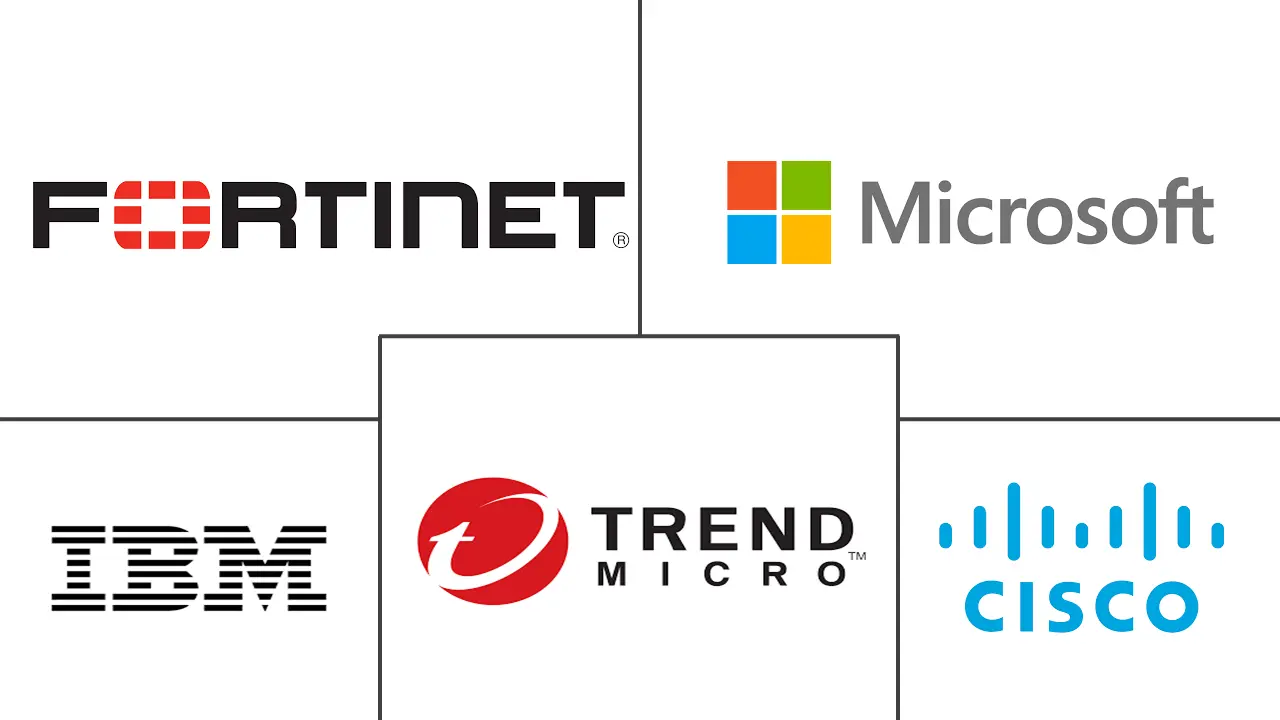Middle East Cybersecurity Market Size and Share
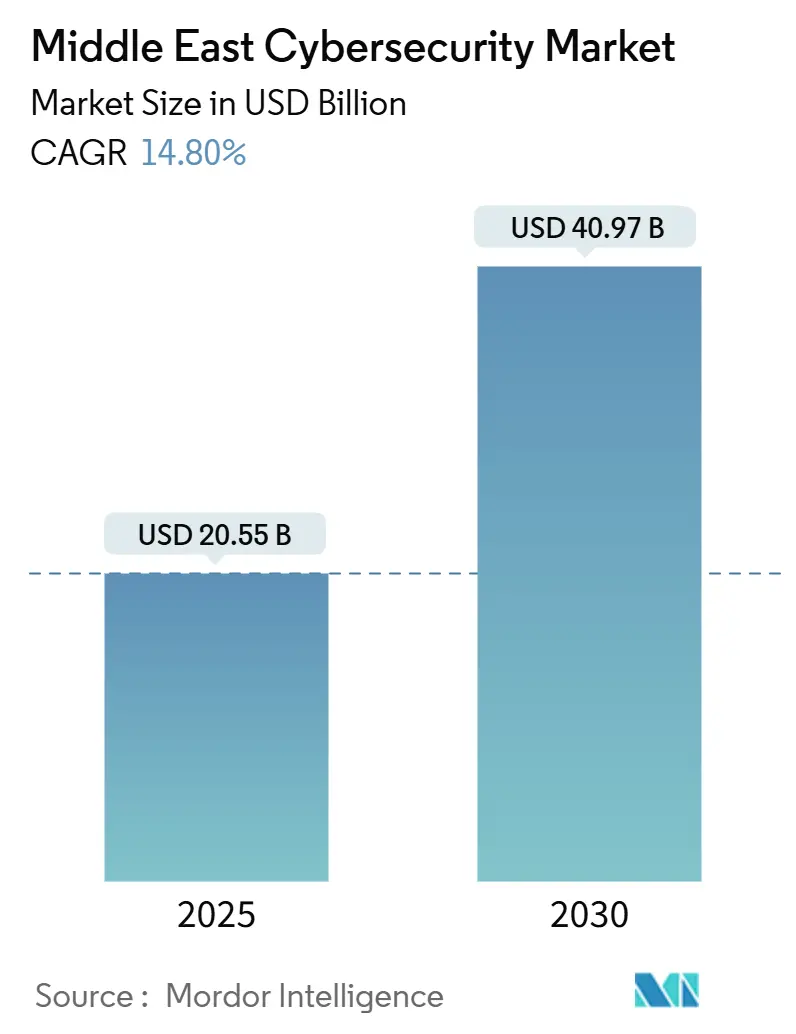
Middle East Cybersecurity Market Analysis by Mordor Intelligence
The Middle East cybersecurity market size is estimated at USD 20.55 billion in 2025 and is expected to reach USD 40.97 billion by 2030, at a CAGR of 14.80% during the forecast period from 2025 to 2030. Accelerated digitalization, persistent nation-state attacks, and mandatory compliance spending under national transformation programs are fueling demand. Critical-infrastructure breaches such as the two-year Iranian infiltration of regional operational networks have shifted budgets from discretionary tools to zero-trust platforms. Government “Vision” agendas in the GCC are transforming cybersecurity into a baseline cost of doing business, while cloud migration and AI adoption across public agencies create new attack surfaces that require specialized defenses. Talent shortages and fragmented data-sovereignty rules temper progress, but a growing pool of local managed-security providers and international partnerships is beginning to ease implementation frictions.
Key Report Takeaways
- By offering, solutions commanded a 53% share of the Middle East cybersecurity market size in 2024, while services are forecast to grow at a 19% CAGR between 2025 and 2030.
- By deployment mode, On-premise installations accounted for a 27.6% share of the Middle East cybersecurity market size in 2024; cloud-based rollouts are projected to track an 18.9% CAGR to 2030.
- By organisation size, large enterprises captured 52.8% of the Middle East cybersecurity market share in 2024, and SMEs are advancing at a 17.8% CAGR through 2030.
- By end user, the BFSI sector held a 21.4% revenue share in 2024; healthcare is projected to compound at a 20.6% CAGR through 2030.
- By country, the United Arab Emirates led the Middle East cybersecurity market share in 2024, whereas Israel is expected to expand at an 18% CAGR through 2030.
Middle East Cybersecurity Market Trends and Insights
Drivers Impact Analysis
| Driver | (~) % Impact on CAGR Forecast | Geographic Relevance | Impact Timeline |
|---|---|---|---|
| Surge in nation-state and critical-infrastructure attacks | +3.2% | UAE, Saudi Arabia, Israel | Medium term (2–4 years) |
| Government “Vision” programmes mandating cyber budgets | +2.8% | GCC core, Jordan, Egypt | Long term (≥4 years) |
| Cloud-first and SaaS adoption across GCC public sector | +2.1% | UAE, Saudi Arabia, Qatar | Short term (≤2 years) |
| AI-driven security analytics lowering MTTR | +1.9% | UAE, Saudi Arabia, Israel | Medium term (2–4 years) |
| M&A wave among local MSSPs creating bundled offerings | +1.4% | UAE, Saudi Arabia | Short term (≤2 years) |
| Oil-and-gas OT retrofit to zero-trust architectures | +1.6% | Saudi Arabia, UAE, Kuwait, Oman | Long term (≥4 years) |
| Source: Mordor Intelligence | |||
Surge in Nation-State and Critical-Infrastructure Attacks
State-sponsored groups have shifted from smash-and-grab intrusions to patient, multi-year footholds in operational networks, as illustrated by the Lemon Sandstorm campaign that exploited VPN flaws across regional utilities.[1]Lemos, Robert, “Lemon Sandstorm Reveals Risks to Middle East Infrastructure,” Dark Reading, darkreading.com Iranian-linked actors maintained covert access for up to 24 months, underlining the strategic value adversaries place on disruption capabilities. Governments have responded with real-time threat-intelligence exchanges; the UAE Cyber Security Council’s pact with Group-IB now coordinates incident-response playbooks across 15 jurisdictions. Heightened geopolitical tension therefore sustains premium spending on endpoint hardening, OT visibility tools, and forensics services.
Government “Vision” Programmes Mandating Cyber Budgets
Legally binding transformation roadmaps in Saudi Arabia, the UAE, and Qatar designate cybersecurity as a national-security pillar, turning once-optional licences into enforceable line items. Saudi regulations introduced in December 2024 stipulate penalties of up to SAR 25 million for non-compliance, effectively assuring multi-year procurement pipelines.[2]Two Birds, “Saudi Arabia: National Cybersecurity Authority Regulations 2024,” twobirds.com The UAE targets AI contributing 20% to non-oil GDP, so every digital service rollout must undergo security accreditation before launch. Mandatory baselines elevate the Middle East cybersecurity market from project-based expenditure to recurring-budget status.
Cloud-First and SaaS Adoption Across GCC Public Sector
Chief AI officers in UAE ministries and blockchain pilots inside Saudi banks are pushing sensitive data into shared infrastructures, making cloud controls and secure access service edge (SASE) platforms indispensable. Google Cloud’s centre of excellence in Abu Dhabi is projected to avert USD 6.8 billion in cybercrime losses by 2030, emphasising the economic upside of proactive investment.[3]UAE Cyber Security Council, “Empowering Cyber Defense: UAE and Google Cloud to Collaborate on Cybersecurity,” googlecloudpresscorner.com Sovereignty clauses remain, but confidential-computing rollouts allow agencies to encrypt data in use, smoothing the migration path.
AI-Driven Security Analytics Lowering MTTR
Regional enterprises view machine-learning telemetry as the only way to close detection gaps without quadrupling headcount. Surveys show 99% of UAE organisations acknowledge AI’s resilience benefits, and 49% plan extra budgets explicitly for analytics use-cases.[4]Zawya, “UAE organisations ramp up AI investments, boosting data compliance and cyber resilience,” zawya.com Banks deploy behavioural models for fraud prevention that align with SAMA’s supervisory guidance. Vendors offering model-agnostic data pipes and local-language threat libraries are gaining traction.
Restraints Impact Analysis
| Restraint | (~) % Impact on CAGR Forecast | Geographic Relevance | Impact Timeline |
|---|---|---|---|
| Persistent Talent Gap and Double-Digit Wage Inflation | -2.4% | GCC core, especially Saudi Arabia and UAE | Medium term (2-4 years) |
| Fragmented Data-Sovereignty Laws Across GCC and Levant | -1.8% | Region-wide, varies by country | Long term (≥4 years) |
| Air-gapped legacy SCADA delaying operational-technology upgrades | -1.2% | Saudi Arabia, UAE, Kuwait, Oman | Long term (≥4 years) |
| Unmanaged shadow-IT across SME supply chains | -0.8% | GCC core, extending to Jordan and Egypt | Medium term (2-4 years) |
| Source: Mordor Intelligence | |||
Persistent Talent Gap and Double-Digit Wage Inflation
Rapid digitalisation has outpaced the supply of skilled cybersecurity professionals. Power utilities in Saudi Arabia struggle to fill key roles even as they raise salaries at double-digit rates, compressing margins and delaying project timelines. Universities have expanded course offerings, yet AI, cloud-security, and incident-response expertise remain scarce.
Fragmented Data-Sovereignty Laws Across GCC and Levant
Distinct localisation statutes oblige multinationals to operate parallel environments, inflating architecture complexity. The UAE’s data-protection law carves out multiple sectoral exemptions, while Saudi controls still require particular data classes to remain onshore. Such divergence limits economies of scale for regional service rollouts.
Segment Analysis
By Offering: Solutions Accelerate Past Services
Services revenue is scaling faster than solutions as enterprises shift from incident-driven outsourcing to platform-centric prevention. The segment is forecast to grow 19% annually through 2030, eclipsing the services slice that held 53% of the Middle East cybersecurity market size in 2024. Demand centres on cloud-security posture management, application shielding, and identity orchestration that support zero-trust policies. High-profile infrastructure breaches have propelled real-time visibility tools and anomaly-detection engines into procurement blueprints.
In parallel, professional-services teams retain a niche for compliance audits and red-teaming, but managed-security contracts face pricing pressure as larger customers insource security operations centres. AI-native vendors such as Corgea clinched USD 2.6 million to build automated vulnerability-triage engines adapted to Arabic-language code bases, exemplifying the innovation now feeding the solutions pipeline.
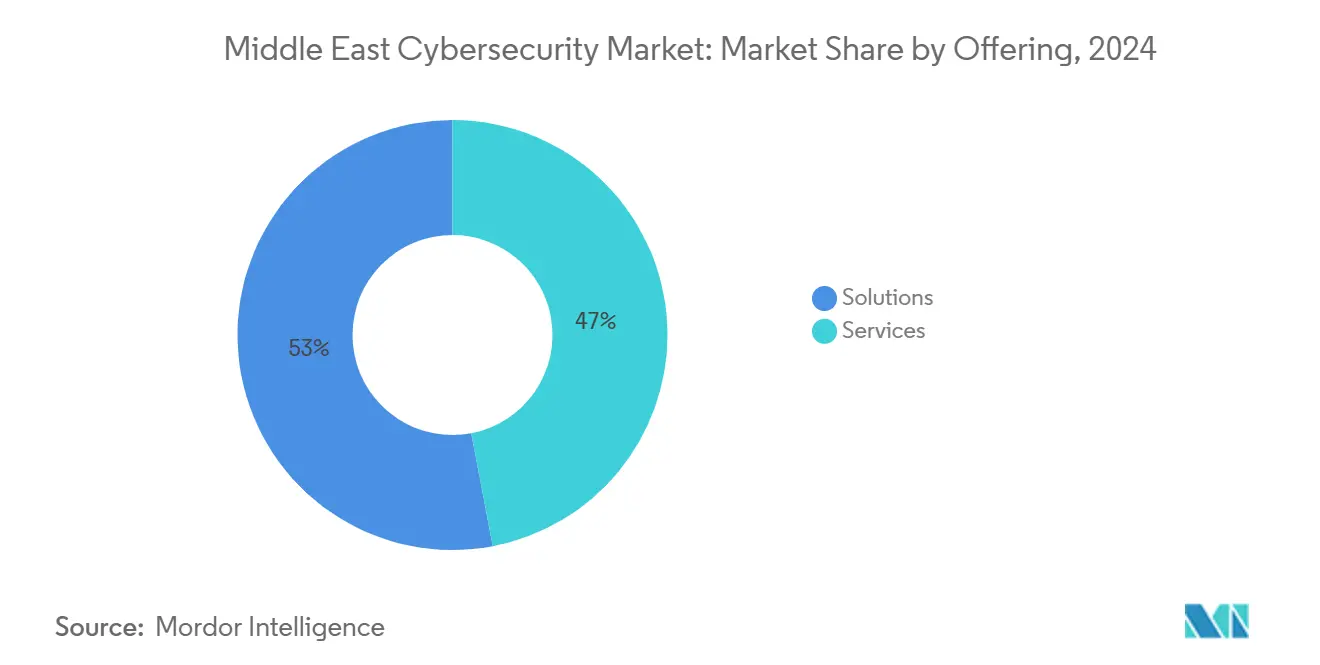
By Deployment Mode: Cloud Gains Despite Sovereignty Concerns
Cloud workloads are projected to expand at an 18.9% CAGR, tightening the gap with on-premise estates that currently command 27.6% of the Middle East cybersecurity market size. GCC ministries embrace "cloud-first" charters to modernise citizen services, spurring uptake of SASE and workload-encryption gateways. Confidential-computing options now offer hardware-based controls that satisfy regulators while preserving scale economies.
On-premise deployments remain the default inside core-banking and defence networks, where data classification rules are stringent. Hybrid models are proliferating; Saudi banks now route inter-bank blockchain transfers through local nodes while storing analytics in sovereign clouds. This dual-stack approach keeps critical data residency intact yet permits AI-driven fraud-monitoring in elastic environments.
By Organization Size: SMEs Drive Unexpected Growth
Large enterprises already represent 52.8% of 2024 revenue and SME will advance at a 17.8% CAGR as awareness climbs and turnkey bundles cut entry hurdles. Regional entrepreneurship agendas, including Monsha’at’s financing schemes, add fresh digital-first firms that regard cybersecurity as a licensing prerequisite. Vendors now package endpoint, email, and cloud-access security into multi-tenant consoles with consumption-based pricing.
Larger enterprises, while already mature, confront new OT challenges in oil, gas, and petrochemicals where 60% of operators deem operational threats more severe than IT threats. Their spend is shifting from perimeter gear toward segmentation gateways and identity governance that spans refinery control networks.
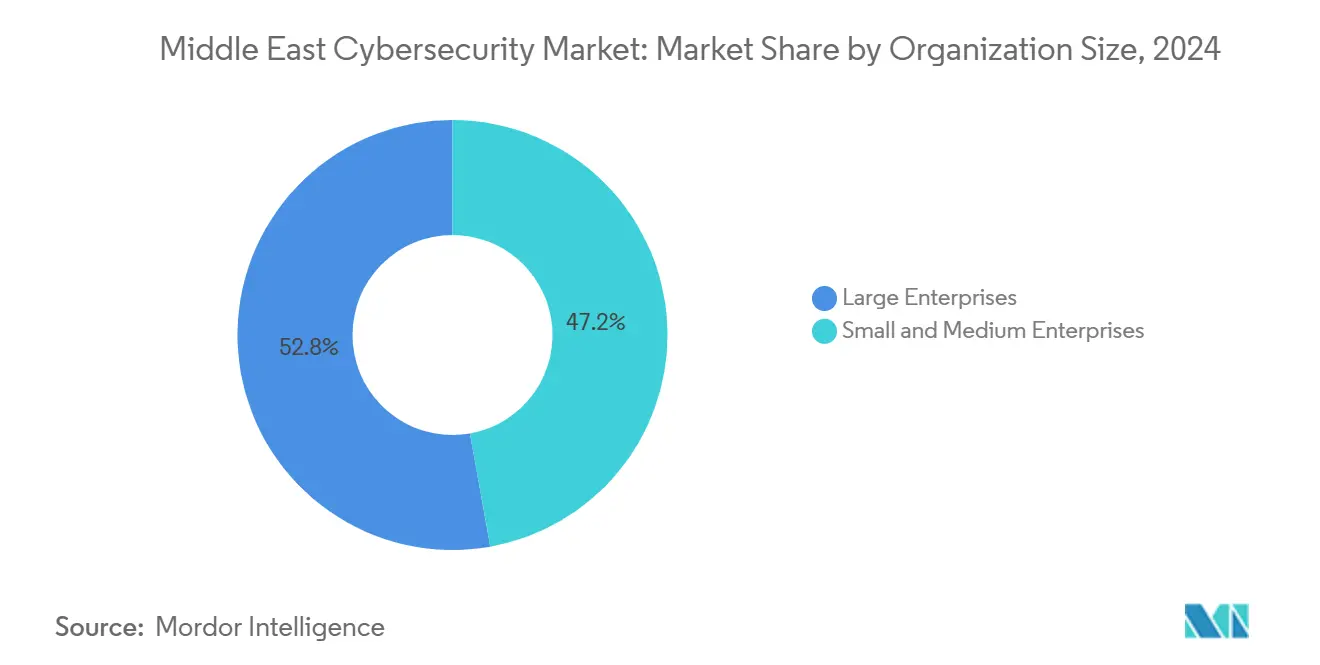
By End User: Healthcare Emerges as Growth Leader
Healthcare spending is rising at a 20.6% CAGR through 2030 as digitised patient workflows, telemedicine, and IoT diagnostics widen attack surfaces. Ransomware incidents targeting hospital chains prompted regulators to demand continuous monitoring and encrypted record transfer, fueling demand for network isolation and anomaly detection. Industry 4.0 principles in smart clinics also elevate identity management and micro-segmentation needs.
Conversely, the Banking, Financial Services, and Insurance (BFSI) sector preserved the largest slice at 21.4% in 2024, owing to capital adequacy rules that require continuous improvement of cyber controls. Regional banks integrate behavioural AI to stop real-time fraud, aligning with SAMA’s supervisory mandates. Energy and Utilities direct budgets toward zero-trust retrofits, while Manufacturing deploys supply-chain security to protect connected production lines.
Geography Analysis
The UAE commands 30% of the Middle East cybersecurity market in 2024. Microsoft’s USD 1.5 billion partnership with G42 illustrates how AI integration necessitates robust cyber controls. The federal data-protection law provides a harmonised baseline that welcomes international vendors while obliging them to store critical data locally. Dubai’s Electronic Security Center issues sector-specific playbooks, and the newly launched centre of excellence with Google Cloud is expected to prevent USD 6.8 billion in losses by 2030. Together, these measures create a procurement environment that favours AI-native platforms and managed threat-intelligence feeds.
Saudi Arabia ranks second by spend and enforces some of the strictest accountability measures in the region. Penalties of up to SAR 25 million came into force in December 2024, obliging boards to certify compliance. The Essential Controls for OT require refinery operators to implement network zoning, asset inventory, and continuous monitoring. SAMA’s blockchain pilot underscores the integration of emerging technologies with stringent security, and public scholarships aim to mitigate the local talent shortfall. These dynamics promise resilient demand for governance, risk, and compliance tooling.
Israel records the fastest expansion, propelled by military-grade R&D and export-oriented cyber vendors. Qatar advances through a centralised National Cyber Security Agency that accredits providers and issues cloud guidelines, creating predictable demand across energy and finance. Egypt’s 82 million-strong internet population makes it the largest attack surface in North Africa, catalysing SOC investments. Smaller GCC economies, Kuwait, Bahrain, and Oman, align with regional standards and tap into pan-GCC cyber-sharing networks, ensuring steady yet moderate growth. Collectively, these diverse policy environments sustain the wider Middle East cybersecurity market as vendors tailor architectures to local compliance idiosyncrasies.
Competitive Landscape
Global suppliers Cisco, Palo Alto Networks, Fortinet and local champions DarkMatter, Help AG, CPX compete in a market that remains moderately fragmented. G42’s acquisition of CPX in February 2025 integrates AI infrastructure with defensive tooling, signalling that cross-domain capabilities will differentiate leaders. DarkMatter’s government-heavy order book, estimated at 80% of revenue, demonstrates the value of sovereign trust.
Saudi firm Cipher secured USD 13.3 million to expand penetration-testing and incident-response rosters. VC backing flows toward AI-driven platforms that address Arabic-language data sets and regional compliance filters. Strategic alliances between energy OEMs and cyber vendors such as Palo Alto Networks pairing with SLB embed security into industrial-control upgrades.
Price competition intensifies in commoditised endpoint niches, while premium margins persist for OT segmentation gateways, confidential-computing chips, and AI threat-hunting modules. The rise of bundled MSSP offerings and sovereign-cloud SOCs is likely to shave share from pure-play consulting firms. Consequently, success will hinge on hybrid delivery models, local-skilled staffing, and demonstrable compliance mappings.
Middle East Cybersecurity Industry Leaders
-
IBM Corporation
-
Fortinet Inc.
-
Cisco Systems Inc.
-
Trend Micro Inc.
-
Microsoft Corporation
- *Disclaimer: Major Players sorted in no particular order
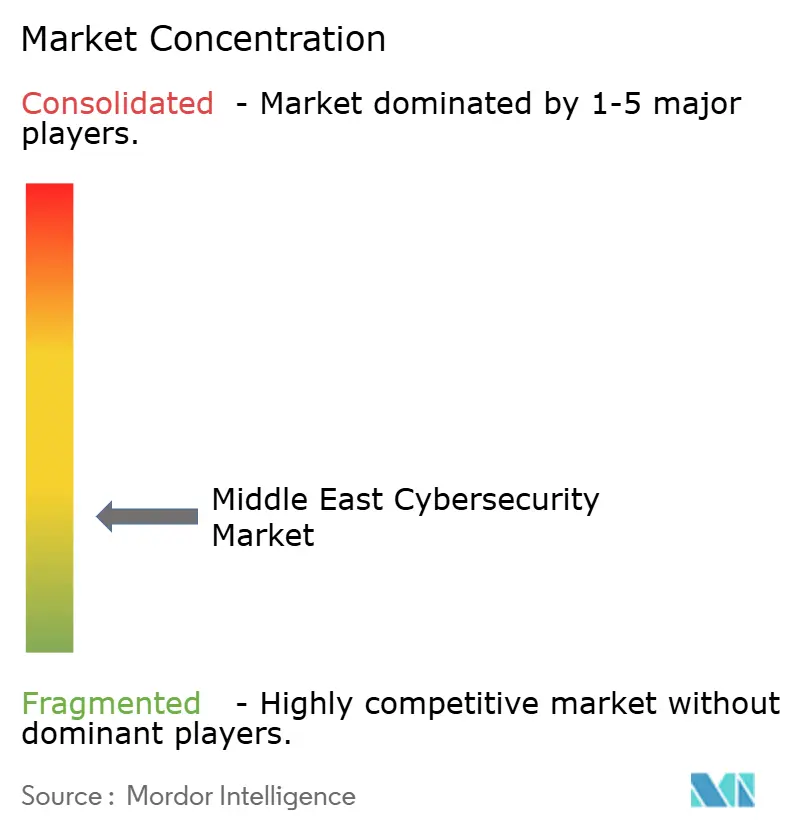
Recent Industry Developments
- April 2025: UAE Cyber Security Council and Google Cloud launched a cybersecurity centre of excellence in Abu Dhabi to reduce projected regional losses by USD 6.8 billion.
- March 2025: UAE government confirmed public- and private-sector targets in a global hack, prompting immediate hardening of critical systems.
- February 2025: G42 acquired CPX Holdings to embed end-to-end security across its AI value chain.
- February 2025: Saudi firm Cipher raised USD 13.3 million to scale assessment and response services.
Middle East Cybersecurity Market Report Scope
Cyber security covers all aspects of protecting an organization and its staff and assets against cyber threats. A wide range of cyber security solutions is needed to reduce corporate cyber risks, given the increasing frequency and sophistication of attacks and more complex corporate networks.
The Middle East cybersecurity market is segmented by offerings (solutions [application security, cloud security, data security, identity access management, infrastructure protection, integrated risk management, network security, end-point security, and other solution types] and services [professional services and managed services]), by deployment (On-premise, and cloud), by organization size (SMEs, large enterprises), by end-user vertical (BFSI, healthcare, IT and telecom, industrial and defense, retail, energy and utilities, manufacturing, and other end-user industries), by country (Saudi Arabia, United Arab Emirates, Qatar, Kuwait, Bahrain, Rest of Middle East [Including Iraq, Jordan, Lebanon, etc.]). The market sizes and forecasts are provided in terms of value in (USD) for all the above segments.
| Solutions | Application Security |
| Cloud Security | |
| Data Security | |
| Identity and Access Management | |
| Infrastructure Protection | |
| Integrated Risk Management | |
| Network Security Equipment | |
| Endpoint Security | |
| Other Solutions | |
| Services | Professional Services |
| Managed Services |
| Cloud |
| On-premise |
| SMEs |
| Large Enterprises |
| BFSI |
| Healthcare |
| IT and Telecom |
| Industrial and Defense |
| Retail |
| Energy and Utilities |
| Manufacturing |
| Other End Users |
| Saudi Arabia |
| United Arab Emirates |
| Qatar |
| Kuwait |
| Bahrain |
| Egypt |
| Rest of Middle East |
| By Offering | Solutions | Application Security |
| Cloud Security | ||
| Data Security | ||
| Identity and Access Management | ||
| Infrastructure Protection | ||
| Integrated Risk Management | ||
| Network Security Equipment | ||
| Endpoint Security | ||
| Other Solutions | ||
| Services | Professional Services | |
| Managed Services | ||
| By Deployment Mode | Cloud | |
| On-premise | ||
| By Organization Size | SMEs | |
| Large Enterprises | ||
| By End User | BFSI | |
| Healthcare | ||
| IT and Telecom | ||
| Industrial and Defense | ||
| Retail | ||
| Energy and Utilities | ||
| Manufacturing | ||
| Other End Users | ||
| By Country | Saudi Arabia | |
| United Arab Emirates | ||
| Qatar | ||
| Kuwait | ||
| Bahrain | ||
| Egypt | ||
| Rest of Middle East | ||
Key Questions Answered in the Report
What is the current value of the Middle East cybersecurity market?
The market is valued at USD 20.55 billion in 2025 and is on track to reach USD 40.97 billion by 2030.
Which country leads regional spending on cybersecurity?
The United Arab Emirates holds the largest country share at 30% of 2024 revenue.
Which sector is growing fastest in cybersecurity demand?
Healthcare is expanding at a 20.6% CAGR through 2030 as hospitals digitalise and protect patient data.
How are national “Vision” programmes influencing budgets?
Regulations under initiatives such as Saudi Vision 2030 mandate minimum security controls, converting cybersecurity into a non-discretionary operating cost.
Why is cloud security becoming a priority despite data-residency rules?
Confidential-computing and sovereign-cloud models let agencies leverage elastic resources while keeping sensitive data under national jurisdiction.
What is the main barrier to faster market growth?
A persistent shortage of skilled cybersecurity professionals drives wage inflation and slows project rollouts, especially in Saudi Arabia and the UAE.
Page last updated on:
